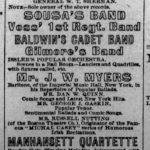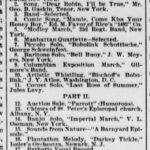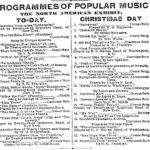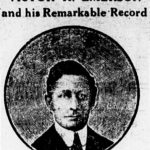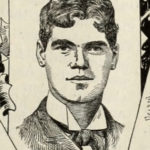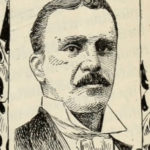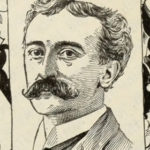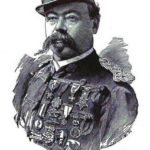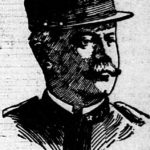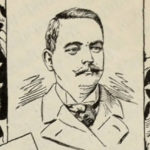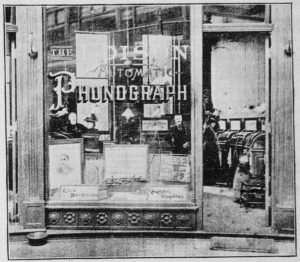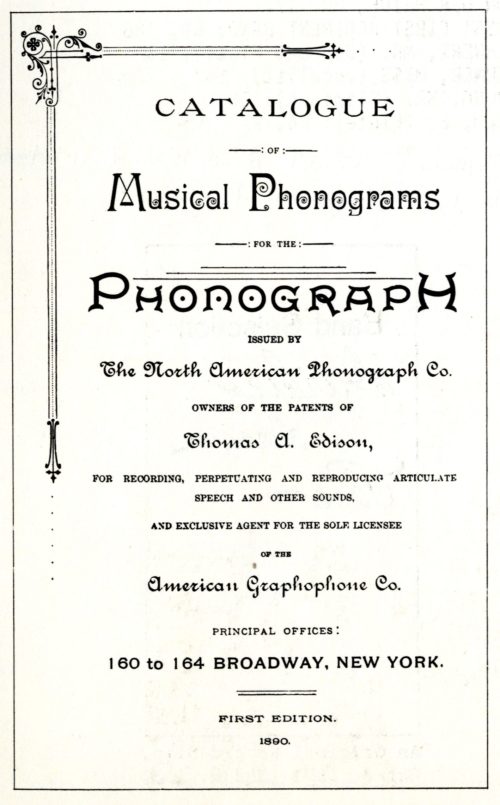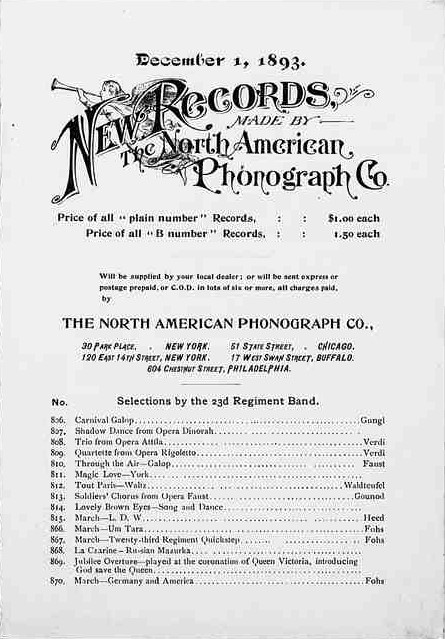Post written by Mason Vander Lugt, National Recording Preservation Board. This is the third in a series of studies of the early recording industry. The first two parts, about the North American Phonograph Company and Columbia Phonograph Company, provide useful background information.
“Why is it that the companies manufacturing musical records do not advertise them as the Columbia Phonograph Co. does, giving lists, with the name of each piece?”, wrote Thomas Conyngton to Phonogram in April 1892. Suppressing a sarcastic “why indeed?”, I gave Conyngton’s query some thought and wondered if the persistent lack of documentation might be something other than a conspiracy against researchers after all.
Why did Columbia request catalog readers to “please destroy all previous lists”? Why didn’t they or New Jersey list their artists? It was obvious, really. In the days before duplication, printing a catalog or advertisement meant committing to keep an artist engaged to maintain stock. Printing a name alongside further committed the company to retain a particular person, with all the vagaries of daily life, not to mention show business.
Still, it was clear by summer 1890 that the entertainment uses of the phonograph were the most, if not only, profitable side of the business, so the companies got creative. Some would contract with independent recordists or artists; some would send agents to nearby venues to capture local or traveling performers. Many would open limited recording departments for their local trade, and a few would develop this to an industrial scale and market their products nationwide. Despite most companies’ reluctance to advertise, I believe a sketchy but worthwhile picture of their recording activity can be drawn from the conventions and Phonogram, and newspaper advertisements for exhibitions or parlors.
As previously noted, an 1891 Phonogram article identified Columbia, New Jersey, New York and Ohio as the industry’s major players. At the annual convention the following summer, Chairman A.W. Clancy asked which companies were recording, and (presumably by roll-call) added Michigan, New England, Kansas and Louisiana to the list. Various comments in the conventions and magazine suggest both the Eastern and Western Pennsylvania companies, the Chicago and State companies of Illinois, the Metropolitan, Pacific, Spokane, Kentucky and Nebraska companies also tried their hands. Several more advertised records “for sale” or “in stock” without indicating whether they had taken them.
Browsing newspaper advertisements for exhibitions and parlors, however, delivers a more sober picture. From Honolulu to Philadelphia, and everywhere in between, the lion’s share of recorded entertainment came from the same few companies and artists. Concerts may be punctuated by live performances or recording demonstrations, parlors might mix in some local talent, but programs for each are surprisingly uniform. As Tim Gracyk noted in Popular American Recording Pioneers – “It is remarkable how much was recorded by a relatively small number of artists!”
The New Jersey Phonograph Company was undoubtedly Columbia’s closest competitor. The Newark-based company inherited much of Edison’s practiced talent, including Issler’s Orchestra, Voss’ 1st Regiment Band, George J. Gaskin and the Manhansett Quartette. Recordist, exhibitor and later manager Victor Emerson also recruited new performers, making stars of Len Spencer and Charles A. Asbury.
- Victor Emerson
- Edward Issler
- Len Spencer
- Charles A. Asbury
Two catalogs from the company exist, both in the Library of Congress’ Recorded Sound collections. The first is undated but is probably from mid-1891. It was reprinted in Talking Machine Review #10. It comprises 15 pages of uncredited band, orchestra, instrumental and vocal music, a small section of vocal [with] orchestra by John P. Hogan and an uncredited series of imitations of sounds from nature. It’s a safe bet that the orchestra was Issler’s. The band was probably Voss’. Repertoire and registers suggest particular singers but I’ll allow readers to speculate if they’d like. Notably, this catalog seems to represent the first attempt to establish a numbering system across a company’s entire catalog, rather than by category as Columbia did.
The second catalog expands enormously from 15 to 32 pages, surpassing even Columbia’s to that date. It’s dated 1892 in print on the cover, and a handwritten note suggests it was published in October of that year. The catalog brings the vocal section to the fore, hinting at a budding specialization. Len Spencer is the star of the show, with 7 pages to Issler’s 5, and a variety of genres and pseudonyms. These are rounded out by chimes, violin, bugle calls, burlesque theater, Irish humor – there’s something for everyone.
The second catalog, and advertisements in Phonogram 3:2 and 3:3/4 (Spring 1893) include New York based bands (Gilmore’s, Holding’s, Bayne’s) and singers (George W. Johnson, Dan W. Quinn, J.W. Myers). Because each company held exclusive rights within their territory, it was standard practice to sell each other’s recordings without noting their source. This is especially problematic between New Jersey and New York, who recorded prolifically in the same area and didn’t include their companies’ names in announcements.
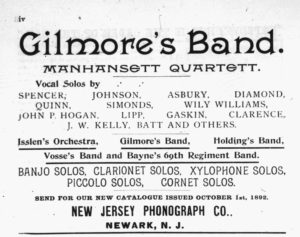 Advertisements like this one make it difficult to know who originally took the recordings. Image from Phonogram 3:2.
Advertisements like this one make it difficult to know who originally took the recordings. Image from Phonogram 3:2.
The New York Phonograph Company was organized by brothers John and Richard Haines to serve those parts of New York State outside of the New York City metro area, which were claimed by the Metropolitan company. The two combined in mid/late 1890 due to financial pressure. Recording and exhibitions were managed by George B. Lull.
Metropolitan’s and New York’s first recordings were taken by local independent recordist Charles L. Marshall and distributed throughout the country[i]. Marshall was an ambitious and talented recordist and in 1889 and 90 seemed to record on a level comparable with or exceeding any of the sub-companies. In later years he would exhibit for New England, open his own parlor, and devise a “scenic theater” combining the phonograph and cyclorama.

Charles Marshall, from Phonogram 1:3, Trinity Church photo from King’s Handbook of New York City 1893 via British Library
New York’s only catalog is a rebranded copy North American’s January 1890 list, with added categories for “Manhansett Quartettes” and “Vocal Solos”, and mention of banjo, xylophone, piplaphone (marimba?) and whistling solos. The Phonogram advertisements (1:8, 1:9, 1:10, 2:1) feature Gilmore’s and Holding’s Bands, Edward Clarance, Joe Natus, and J.W. Myers alongside performers associated with other companies like Russell Hunting and Charles P. Lowe.
- Edward Clarance
- George W. Johnson
- John P. Hogan
- Carlo A. Cappa
A June 1893 article in the New York Sun identifies Clarance as NYPC’s primary recordist, announcer and talent scout, and Frank Banta as their house pianist. It describes Clarance’s tactics – “In his search for things new and original, Mr. Clarance has formed the acquaintance of nearly every man and woman in the city who can play an instrument or sing uncommonly well”. It goes on in some detail about recording John Holding’s popular descriptive[ii] “The Night Alarm”, Frank Mazziotta playing “tumblers filled with water” (glass harp), and the reliability of Gilmore’s Band. Banta and Mazziotta would record frequently with Edison in later years.
John B. Holding’s “The Night Alarm” was one of the decade’s undisputed “hits”. Audio via University of California, Santa Barbara Library.
Several more New York based bands (Alfred Foh’s 23rd Regiment Band, Carlo Cappa’s 7th Regiment Band, Henry Hall’s Old Guard Band, William Bayne’s 69th Regiment Band) are among the most popular in newspaper advertisements and in the absence of other data I assume these were taken by NYPC.
The company was positioned to capture the great opera, musical theater, dramatic and art music stars. At the fourth convention in Sept. 1893, Haines notes “The New York Phonograph Co. has been able, from time to time, to make records of a high order in small quantities, and in some few cases we have made records of a high order in large quantities, celebrated singers, etc.”, but unfortunately doesn’t elaborate. A November 1892 Phonogram article describes a prominent New York based collector who owned recordings of the Metropolitan Opera Orchestra, Leopold Godowsky, actor Lawrence Barrett and poet Amelie Rives but doesn’t note their source. An October 1892 article noted that “The piano solos of the New York Co. are specially fine”.
Despite New York’s long recording tenure[iii] and Haines’ claim that the company “manufacture a very large number of musical cylinders”[iv], New York’s recordings remain somewhat obscure due to minimal advertising and confusion between their and New Jersey’s recordings. It is possible some artists recorded for both. A rare program noting records’ sources in Phonogram 3:2 lists a Holding record taken by New Jersey and a Myers record taken by New England, though some simple errors cast some doubt on these as well.
The New England Phonograph Company was organized October 1888 in Gardiner Maine, then moved to the Boylston Building in Boston in May 1889. It was managed by Augustus Sampson, and the exhibition department was managed first by F.A. Ashcroft then Charles L. Marshall.
The company was frequently praised in Phonogram for their high-quality band records, taken by Calvin G. Child who would go on to record for Columbia, Ohio, Berliner and Victor in the following years. Acoustic recording was an art and science developed painstakingly over years of trial and error, and each company cultivated the skills of one or more expert recordists[v].
Baldwin’s Cadet Band, led by J. Thomas Baldwin, and Russell Hunting’s “Michael Casey” series of Irish comic skits were New England’s best-sellers. Vocalists Will F. Denny, Edward M. Favor and Richard Jose first recorded for New England and would each go on to successful recording careers.
- J. Thomas Baldwin
- Russell Hunting
- Will F. Denny
An August 1893 catalog in a private collection reflects that the Cadet Band’s repertoire was deeply influenced the United States Marine Band’s Columbia records. It also features several pages of “Henry’s Orchestra”, led by Thomas W. Henry who had previously played in Gilmore’s Band (as had Baldwin). The catalog concludes with a small section for Charles E. Cooper’s Celebrated Fife, Drum and Bugle Corps and solos by the late great cornetist Walter Emerson.
The Ohio Phonograph Company was organized November 1888, with offices in Cincinnati and Cleveland. It was managed by James L. Andem, a hard-headed visionary in the style of Edward Easton.
Ohio’s star was Dan Kelly, whose “Pat Brady” series of comic Irish skits were often called the most popular series in the country. The Bison City Quartette, a comic troupe already famous on the stage, also found widespread success recording for Ohio.
“Paddy’s Wedding”, recorded by Dan Kelly for the Ohio Phonograph Company ca. 1891. Recording from “Antique Phonograph Music Program“, aired 4/15/2003 on WFMU, by permission. [vi]
The only surviving catalog from this company is undated, but was probably published in 1894. Most of the recordings seem to have been imported from the eastern companies, but it also features a local 15 year old contralto named Rose Monks, famous minstrel performer Will Nankeville, cornet virtuoso Alice Raymond and John Weber’s Band of Cincinnati.
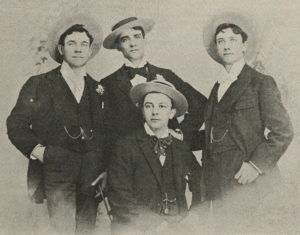
The Bison City Quartette ca. 1893, from “His Only Boy” sheet music via NYPL. Thanks to Archeophone Records for including the image in “Waxing the Gospel”
The company also pioneered phonograph “arcades”, or parlors, when most companies were placing individual machines in public spaces such as hotel lobbies, saloons and train or ferry terminals. The arcade allowed the company to monitor how the machines were used and maintain the phonographs and replace records as needed.
Two views of Ohio’s Arcades, from Phonogram 1:11-12
The Louisiana Phonograph Company was founded by F.E. Clarkson, and soon managed by Hugh Conyngton who had previously managed the all-business Texas Phonograph Company in Galveston. It was the last sub-company to form, in March 1891, but by the following January was “turning out large supplies of musical records”.
In their own words, “New Orleans is perhaps the most generally musical city of our country and its musicians are very fine”. It was also a resort town, and a description in Phonogram depicts the romantic scene awaiting their patrons – an electric-lit parlor in the city’s west end abutting Lake Pontchartrain, with cool breezes and first-class bands.
 Louisiana Phonograph Co. ad, summer 1892, from Phonogram 2:6
Louisiana Phonograph Co. ad, summer 1892, from Phonogram 2:6
Advertisements only list two associated performing acts. Paoletti’s Southern Band, led by George Paoletti, played dances, marches and opera overtures, an arrangement of Dixie “as played in the South” providing the only apparent namesake. Louis Vasnier performed comic sermons in dialect as “Brudder Rasmus” and a variety of minstrel songs with banjo. Remarkably, one of the “Rasmus” records survived the years and climate and was reissued on Archeophone’s “Lost Sounds” CDs accompanying Tim Brooks’ book, which discusses Vasnier and George W. Johnson in detail.
Conclusion
Most of the sub-companies dissolved after North American ceased business operations in August 1894. They were sales agents, after all, not manufacturers. The heads of the New Jersey and Kansas companies had formed an independent venture called the United States Phonograph Company in spring 1893 to bypass their sales restrictions as sub-companies. Columbia similarly distanced itself by merging with the American Graphophone Company and manufacturing phonograph-compatible graphophones and supplies after Jesse Lippincott’s death in April 1894. American Graphophone would attempt to secure Columbia a monopoly of the recording business by enjoining Edison and the sub-companies from using Bell and Tainter’s recording process, but would mostly fail.
James Andem continued to run the Ohio Phonograph Company independently, expanding into Kinetoscopes, recording new artists like Brand’s Concert Band and The Ideal Orchestra, and publishing the only trade paper in the years between Phonogram and Phonoscope, titled Edison Phonographic News. New England would continue advertising Baldwin’s Cadet Band records until at least October 1898. New York dropped out of the business by July 1895[vii].
After a protracted legal process, Thomas Edison bought North American’s assets and founded the National Phonograph Company in January 1896. Andem organized several of the remaining sub-companies, including New York and New England to sue Edison and National for violating their territorial rights. Most would end in settlements. By 1900 only Edison and Columbia would remain in the business. The next and final installment in this series will investigate the independent record manufacturers of the later 1890s.
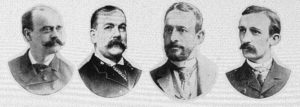
Sampson, Andem, Haines and Easton, adapted from Phonogram 1:11-12
Notes
- [i] “The Following Record” p. 148
- [ii] A “descriptive” was a popular band form, sometimes with sound effects or speaking, meant to suggest a narrative, similar to classical “program music”
- [iii] Remember, New York supplied North American with recordings at the beginning and end of their recording activities in 1890 and 1894
- [iv] National Phonograph Association 2nd convention (1891), p. 91 original
- [v] “The Following Record” pp. 155-180 The Arts of Recording and Phonogenic Performance goes into some detail about this aspect of the industry
- [vi] It’s worth noting it’s possible this recording is a fake. Conditions were ripe for forgeries with star power like Kelly’s bringing high profits, and little accountability for pirates. With no other examples to compare (that I know of) we can’t know for sure…
- [vii] NYPC vs. National, p. 154-155 (image 88)

